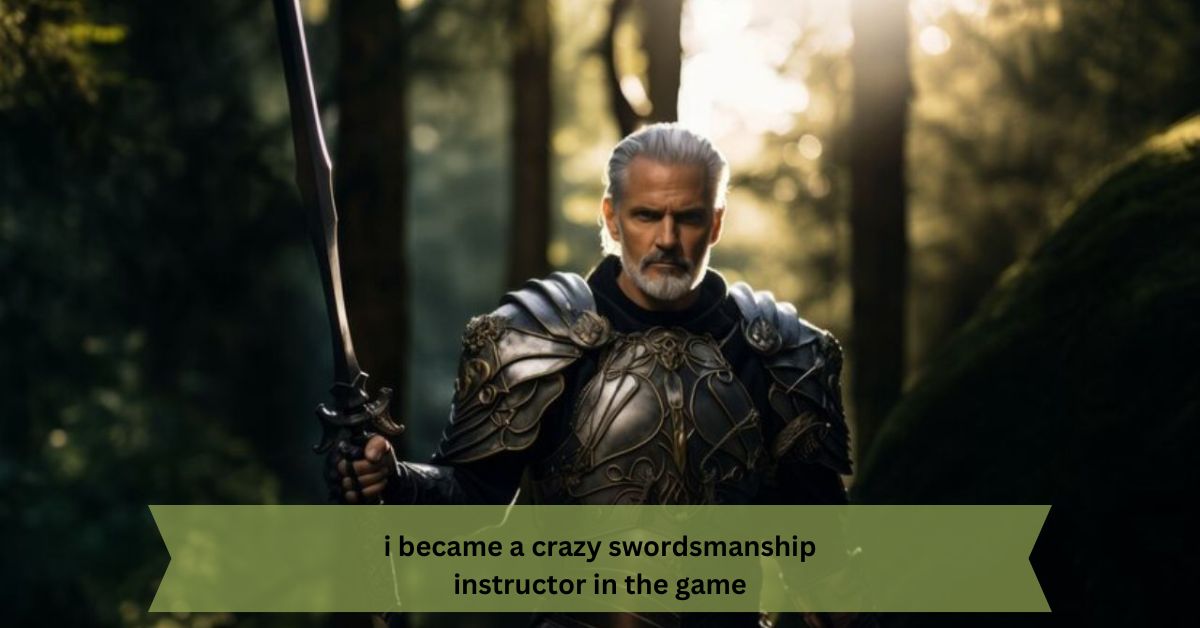Introduction
In the ever-evolving landscape of virtual worlds, players often find themselves drawn into roles that challenge both their skills and imagination. Among these, the role of a swordsmanship instructor offers a unique blend of strategy, combat expertise, and mentorship.
What is “I Became a Crazy Swordsmanship Instructor in the Game”?
“I Became a Crazy Swordsmanship Instructor in the Game” is more than just a storyline—it’s a unique role-playing experience that immerses players in the world of teaching and mastering the art of swordsmanship.
In this game, you don’t just fight enemies; you guide others, develop strategies, and push the boundaries of what’s possible with a blade. As the title suggests, the role is not for the faint of heart—it’s for those who are willing to embrace the craziness that comes with being a mentor in a high-stakes environment.
The Role of a Swordsmanship Instructor: Beyond the Basics
Understanding the Role
As a swordsmanship instructor, your primary duty is to train new players or NPCs (non-playable characters) in the art of combat. This involves teaching basic sword techniques, advanced maneuvers, and battle strategies.
But it doesn’t stop there. The “crazy” aspect of the role implies that you’re not just an ordinary instructor; you’re one who pushes the limits, challenges conventional wisdom, and sometimes adopts unorthodox methods to achieve mastery.
The Path to Becoming a Swordsmanship Instructor
In the game, becoming a swordsmanship instructor is not an overnight achievement. It requires dedication, skill, and a deep understanding of the game’s mechanics.
Typically, players must first excel in swordsmanship themselves, mastering various techniques and proving their worth in numerous battles. Only then are they offered the opportunity to teach others.
Embracing the “Crazy” Aspect
The “crazy” in the title isn’t just for show. As an instructor, you’re expected to take on challenges that others might shy away from. This could mean developing new techniques on the fly, facing overwhelming odds in battle, or even pushing your students to their limits in ways that seem extreme.
This approach, while unconventional, often leads to breakthroughs and significant progress for both the instructor and the students.
My Journey: From Novice to Master Instructor
The Early Days: Learning the Basics
Like many players, I started as a novice, struggling to grasp the basics of swordsmanship. The game was unforgiving, and every mistake was met with swift consequences. However, these early challenges were crucial in shaping my understanding of combat.
I spent countless hours honing my skills, studying different techniques, and learning from my mistakes. This period was marked by frustration, but it also laid the foundation for my future role as an instructor.
The Turning Point: Embracing the Unconventional
The turning point in my journey came when I realized that traditional methods weren’t enough. The game demanded more—something beyond the usual approach to combat.
This is when I began experimenting with unconventional techniques, blending different styles, and pushing the limits of what was considered possible.
My gameplay became more unpredictable, and while it earned me a reputation as a “crazy” player, it also brought success in battles that others deemed unwinnable.
Becoming an Instructor: The Challenges and Rewards
Transitioning from a player to an instructor was a significant shift. No longer was I just focused on my own progress; I was now responsible for guiding others. This role came with its own set of challenges—each student had different strengths, weaknesses, and learning styles.
However, it was also incredibly rewarding. Seeing my students improve, develop their own unique styles, and succeed in battle brought a sense of accomplishment that surpassed my personal victories.
Advanced Swordsmanship Techniques: What I Taught My Students
The Art of Timing and Precision
One of the first lessons I emphasized to my students was the importance of timing and precision. In swordsmanship, every move counts, and even a split-second delay can be the difference between victory and defeat.
I taught them to read their opponents, anticipate their moves, and strike at the right moment. This lesson was not just about the physical act of swinging a sword but also about understanding the psychology of combat.
Combining Offense and Defense
Another key aspect of swordsmanship that I focused on was the seamless integration of offense and defense. Many players make the mistake of treating these as separate actions—either attacking or defending.
However, true mastery comes from the ability to switch between the two fluidly, using defense as a platform to launch an attack and vice versa. I drilled this concept into my students, helping them develop a style that was both aggressive and resilient.
Developing Unorthodox Techniques
As a “crazy” instructor, I encouraged my students to think outside the box. I introduced them to unorthodox techniques that weren’t covered in the standard training manuals.
This included everything from using the environment to their advantage to employing psychological tactics to unsettle their opponents. These techniques, while unconventional, often gave them the upper hand in difficult battles.
The Impact of My Teaching: Stories of Success
Student A: From Novice to Master Swordsman
One of my most memorable students was a player who started with little to no experience in swordsmanship. They struggled with the basics and often found themselves overwhelmed in battles. However, through persistence and a willingness to embrace my “crazy” methods, they gradually improved.
By the end of their training, they had developed a unique style that combined speed, precision, and unpredictability, earning them the title of a master swordsman in the game.
Student B: Overcoming the Odds
Another success story involved a player who was constantly underestimated by others due to their lack of physical strength. However, I recognized their potential and focused on teaching them techniques that relied on strategy rather than brute force.
They became adept at using their opponent’s strength against them, turning what was perceived as a weakness into a formidable strength. This student went on to become one of the most respected players in the game.
The Challenges of Being a Crazy Swordsmanship Instructor
Balancing Teaching and Personal Progress
One of the biggest challenges I faced as an instructor was finding the balance between teaching and my own progress in the game.
The role demanded a significant amount of time and effort, and there were moments when I felt my personal advancement was stalling. However, I soon realized that teaching was, in itself, a form of growth.
The process of analyzing techniques, developing strategies, and adapting to my students’ needs deepened my understanding of the game and made me a better player.
Dealing with Resistance from Students
Not every student was receptive to my unconventional methods. Some were skeptical, resistant to change, or simply unwilling to embrace the “crazy” aspect of my teaching.
Overcoming this resistance required patience, communication, and sometimes a demonstration of how these methods could lead to success. It wasn’t always easy, but seeing the eventual progress of these students made it worthwhile.
The Emotional Toll
Teaching in a high-stakes environment can take an emotional toll. The pressure to succeed, the responsibility of guiding others, and the inevitable failures along the way were all challenges that I had to navigate.
There were times when the role felt overwhelming, but the support of my students and the satisfaction of seeing their progress kept me going.
The Legacy of a Crazy Swordsmanship Instructor
The Impact on the Game Community
My journey as a swordsmanship instructor didn’t just affect my students; it also had a broader impact on the game community. My unconventional methods sparked discussions, debates, and even inspired other players to experiment with their own styles.
The title of “crazy swordsmanship instructor” became synonymous with innovation, pushing the boundaries of what was possible in the game.
Passing on the Torch
As time went on, some of my students went on to become instructors themselves, passing on the techniques and philosophies they had learned from me. This created a ripple effect, spreading the influence of my teaching across the game.
The legacy of a “crazy” approach to swordsmanship continued to thrive, shaping the next generation of players.
Conclusion
The journey of becoming a crazy swordsmanship instructor in the game was one of the most challenging and rewarding experiences I’ve had in the virtual world. It taught me the value of pushing boundaries, embracing the unconventional, and never underestimating the power of teaching.
FAQs
1. What is the key to becoming a successful swordsmanship instructor in the game?
The key is to master the basics of swordsmanship, embrace unconventional techniques, and be willing to push both yourself and your students to their limits.
2. How do I deal with students who are resistant to my teaching methods?
Patience and communication are essential. Show them the value of your methods through demonstrations and encourage them to keep an open mind.
3. Can anyone become a swordsmanship instructor in the game?
While anyone can aspire to become an instructor, it requires dedication, skill, and a deep understanding of the game’s mechanics



